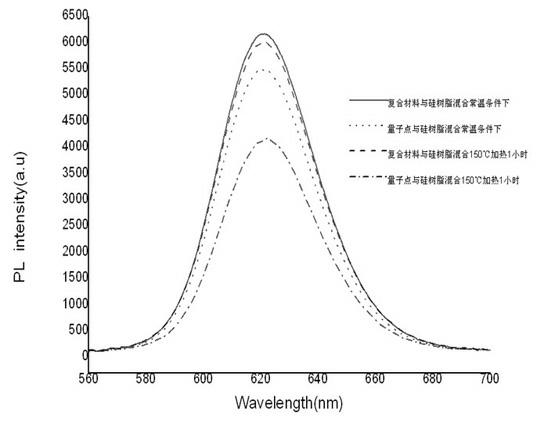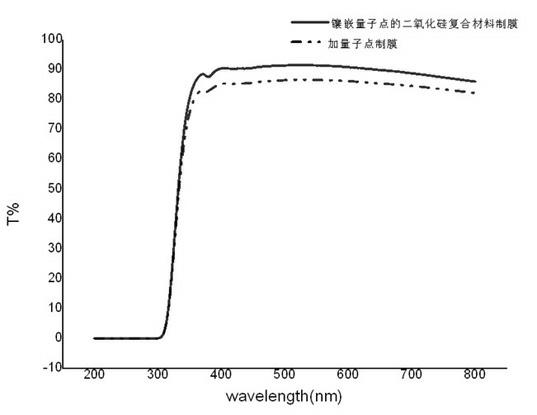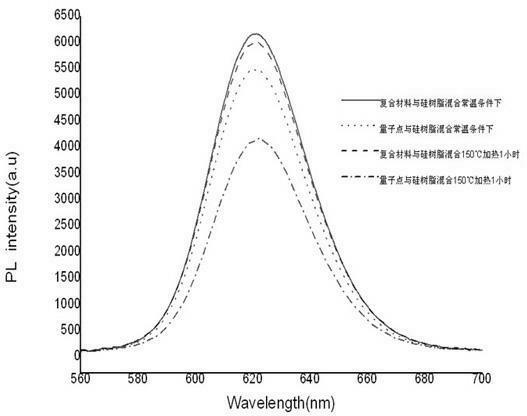Quantum dot-embedded porous silicon dioxide composite material, and preparation method and application thereof
A technology of porous silica and composite materials, applied in chemical instruments and methods, luminescent materials, electrical components, etc., can solve problems such as increased production cost and difficulty, prone to agglomeration, complicated operation, etc. The effect of improving UV resistance and simple preparation process
- Summary
- Abstract
- Description
- Claims
- Application Information
AI Technical Summary
Problems solved by technology
Method used
Image
Examples
Embodiment 1
[0035] 1. Preparation of cadmium selenide (CdSe) quantum dots
[0036] 1) Add 0.12mmol of cadmium oxide (CdO) and 0.41mmol of stearic acid (SA) in a three-necked flask, use Schlenk technology, degas and inflate for several times, heat to 150°C, keep for 30 minutes, so that CdO is fully dissolved to no Color, then cooled to 50 ℃.
[0037] 2) Add 1.94g of tri-n-octylphosphine oxide (TOPO) with a purity of more than 90% and 1.92g of hexadecylamine (HDA) with a purity of more than 90% into a three-necked flask. Using Schlenk technology, the water and oxygen are drained through a vacuum system, and then heated to 320°C in an argon atmosphere. At this time, use a syringe to quickly inject a stock solution configured with 1mmol selenium (Se) and 2ml tri-n-butylphosphine (TBP), and quickly cool to 260°C for a period of time, and finally withdraw the heating device to cool the product to room temperature .
[0038] 3) Add the same volume of chemically pure chloroform to the liquid obtained...
Embodiment 2
[0046] 1. Synthesis of CdSe quantum dots: prepared according to the same method as in Example 1
[0047] 2. Preparation of porous silica composite material embedded with CdSe quantum dots
[0048] 1) Disperse 10g of the separated and purified semiconductor quantum dots in a mixed solution of toluene and xylene to form a toluene / xylene quantum dot solution;
[0049] 2) Add 90g of porous silica to the above toluene / xylene quantum dot solution and stir well, then add 7g Z-6030 and stir well;
[0050] 3) The mixture obtained in step 2) was sonicated for 12 hours and centrifuged to obtain a colloidal substance. The colloidal substance was repeatedly washed with a toluene / xylene mixed solution, and then centrifuged;
[0051] 4) The material obtained in step 3) is dried and pulverized to finally obtain a porous silica composite material inlaid with quantum dots. The weight ratio of semiconductor quantum dots, surfactant and porous silica in the obtained composite material is 10:7:90.
Embodiment 3
[0053] 1. Preparation of quantum dots with CdSe / ZnS core-shell structure
[0054] 1) Use the method of Example 1 to synthesize cadmium selenide (CdSe) quantum dots, mix them with toluene to form cadmium selenide (CdSe) toluene solution (10ml), and inject the solution into tri-n-octyl phosphine oxide (TOPO) In the mixed solution with hexadecylamine, the toluene is extracted from the reaction system at 100°C by vacuuming;
[0055] 2) After raising the temperature of the system obtained in step 1) to 200°C, add diethyl zinc (ZnEt 2 ) / Tri-n-butyl phosphine (TBP) solution and sulfur (S) / tri-n-butyl phosphine (TBP) solution, after dripping, react at a constant temperature of 200°C and stir for 10-50 minutes, then cool to room temperature;
[0056] 3) Add chemically pure methanol to the solution obtained in step 2) at room temperature. After the solid in the solution precipitates out, centrifuge it at 3000-5000 rpm for 1-10 minutes;
[0057] 4) After centrifugation, discard the upper layer s...
PUM
 Login to View More
Login to View More Abstract
Description
Claims
Application Information
 Login to View More
Login to View More - Generate Ideas
- Intellectual Property
- Life Sciences
- Materials
- Tech Scout
- Unparalleled Data Quality
- Higher Quality Content
- 60% Fewer Hallucinations
Browse by: Latest US Patents, China's latest patents, Technical Efficacy Thesaurus, Application Domain, Technology Topic, Popular Technical Reports.
© 2025 PatSnap. All rights reserved.Legal|Privacy policy|Modern Slavery Act Transparency Statement|Sitemap|About US| Contact US: help@patsnap.com



